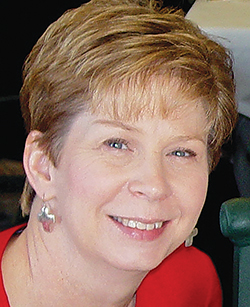
Like any other organization, it is necessary for a church to compile financial reports on a regular basis.
Many churches use Microsoft Excel, which requires constant manual data input from a user on a designated device. The problem with this system is that configuring the information for specific reports requires a lot of work outside the system of record, and it’s not in real time. It’s lots of manual work with a greater chance of errors.
Faith-based organizations these days are moving to the cloud for multiple reasons. It lowers costs, increases access, and is secure and easy to use. It can also easily manage multisite locations and ministries.

Director, Nonprofit Industry Marketing
Sage Intacct
To learn more about the benefits of cloud computing, Church Executive recently partnered with Joan Benson, director of nonprofit industry marketing at Sage Intacct, and MaryFrances Pidgeon, senior nonprofit sales engineer at Sage Intacct, to host a webinar: “Leveraging the Cloud for Quick & Easy Financial Reporting for Faith-Based Organizations.”
In it, Benson and Pidgeon discuss technology in faith-based organizations today, as well as issues facing those organizations and how they can benefit from cloud computing. Pidgeon also provides a dashboard demo to give a better idea of how a best-in-class cloud financial management environment works.
What is cloud computing? Cloud computing is a form of SaaS, or “subscription as a service,” which can be subscribed to and accessed entirely on the internet. This means no hardware, no software and no paying for maintenance and support. This service offers shared, scalable solutions that are accessible from any device, making it mobile-friendly and convenient. Now it’s easy for today’s modern faith-based organization to stay connected, stay plugged in, and access real-time information from anywhere.
How is it different? The biggest difference between the cloud and Excel or dated technology solution is automation. Excel is a desktop software; a user must manually enter data and configure reports. The cloud offers the ability to automate accounting and financial tasks, with sophisticated permissions and approval capabilities so that a user on any device can access what he or she needs.
“It’s all about being able to have best-in-class financial management functionality … without having the manual processes, delays and risk of error that we’ve had in the past.”
— Joan Benson

Senior Nonprofit Sales Engineer
Sage Intacct
Why the cloud? There are numerous advantages to shifting to the cloud: cost savings and stewardship, predictable monthly fees, cybersecurity, IT support, automatic regular updates, and ease of access. Cloud technology allows an organization to benefit from the improved automation and efficiency, while enjoying reduced IT costs and infrastructure.
“As a stand-alone organization, it’s hard for you to afford the best data and security staff in the world. But when we share this across thousands of organizations, we are able to have the best data and security people in the world monitoring, managing, and taking care of this for us,” Benson said. “You no longer have to worry about disaster recovery, your servers, software patches, IT workloads, rewriting custom code, or any of those facility-related issues that you have with on-premise solutions.”
What are the benefits? The main benefits start with enhanced efficiency. The cloud gives users better visibility into their data with more automation, which leads to better and easier reporting. It allows for multisite management, making it more efficient to monitor multiple locations from the same place.
Another benefit is the digital records — no more paper invoices littering the desk.
The cloud also offers sophisticated capabilities in the areas of permissions and approval.
“You have total flexibility and control around allowing access to certain information to the right people at the right time,” Benson said.
This makes it possible to have a secure, paperless office with information available only to those who need it. Now there is a level of transparency and accountability with records of who accessed what information.
Another benefit to best-in-class cloud financial management is the open API architecture which allows you to easily integrate your solutions so you can consolidate information and easily track key metrics — like giving per attendee per location.
Finally, there is the benefit of engagement. Sage Intacct found that giving goes up when a church uses technology that supports online giving. When this happens, members become more engaged and connected to what the church is doing, its mission, and the ministry.
“It’s all about being able to have best-in-class financial management functionality delivered in the cloud in real time and without having the headaches that we’ve had with technology in the past,” Benson said.
— Reporting by Skylar Griego
View the webinar!
“Leveraging the Cloud for Quick & Easy Financial Reporting for Faith-Based Organizations”
Learn how cloud computing can help you provide real-time, customizable and reusable reports; eliminate manual, Excel-based reporting; easily track programs, ministry outcomes and giving metrics; and more.
Available now at
www.churchexecutive.com/webinars
Questions? Readers ask, experts answer.
What about member management groups, pledge tracking, fund accounting and other aspects unique to churches, as compared to church management software platforms?
Joan Benson: We do full fund accounting. We’re a financial management and accounting solution, so we focus our investment on building the best financial management technology. We have an open API, which allows us to easily integrate with other solutions, like your church management solution.
There are lots of church management solutions that integrate with Intacct, and we have people on all different types of products, including Church Community Builder, Fellowship One, and other different church management systems. They select summary data that makes sense to bring to the financial system, and they flow that into Intacct so specific metrics can be tracked.
Does the system work for UK-based organizations?
Benson: Yes, we have multi-currency as of this solution and product. We do have some faith-based international relief organizations that work all over the world and use Intacct in remote locations.
How can you ensure quick and easy reporting if a church has multiple locations?
MaryFrances Pidgeon: By using our dimensional architecture, you have the ability to setup and tag multiple locations when creating any type of transaction. That will allow you to create reports by individual location, all locations side by side to get a clearer picture of each location and even include budget to actual by location if warranted. This underlining architecture helps you to be very granular in how you report, track, and what people can see.
For a brand-new user of your platform, what is the learning curve to become familiar with the system?
Pidgeon: When you go with the Sage Intacct solution, you’ve got what we call an implementation partner. They’re going to help you during the design-and-define phase and help you ramp up. The training is part of that. For that brand-new user, who’s being permissioned to the system, you’re going to have a ramp-up time and a training methodology, and it’s going to be intuitive and seamless.
“Whether you want to filter items on your dashboard, add components, or edit items, it’s all at your fingertips.”
— MaryFrances Pidgeon
Benson: One of the other things that question brings to mind is the community. We have a Sage Intacct community where all different types of users, experts and partners can go to ask questions, get advice and get feedback. We also have a non-profit group within the community, so there are great resources available to help that learning curve be even faster.
Is it true fund accounting?
Pidgeon: I always chuckle at that question. Yes, we’re true fund accounting. It’s innate in the solution today.
Our church has historically used QuickBooks, but we’re thinking about transitioning to the cloud. How long might that take, and what process can we expect?
Pidgeon: We do a lot of what I call ‘QuickBook conversions,’ and church management software conversions. Our methodology will assist you with that mapping. As far as timing, it varies based on the scope of your implementation, and that’s typically determined when you go through a more thorough discovery call.
Benson: It’s easy to migrate, and we have people who do it in 30 days. We also have people who might plan for a 60– or 90-day implementation. It really depends on the scope of your project. If you’re moving from QuickBooks, it’s a pretty simple process and can be done quickly.
How can your platform be used to track specific ministries within the church? What kind of data is key to doing that?
Pidgeon: It’s all around coding and tagging. It’s from the initial define-and-design stage, from our underlining architecture. Those ministries are going to be a dimension, and then there are going to be the different types of ministries. Adult worship, men’s worship, women’s worship, kids’ worship — however you have the different ministries set up. You can have one, five, 10, 20, however many you have, and then during any type of transaction — whether it’s a journal entry, a bill, or an invoice — the tagging and coding of that is what gets you this dynamic reporting that’s very robust. This ability is what most of these organizations lack; they don’t have the ability to track or tag these elements. You will have that ability and the capability within the Sage Intacct solution.


